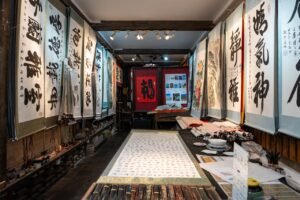In today’s globalized world, art plays an increasingly important role as a bridge between cultures. Whether you are an artist, a designer, a student, or simply an enthusiast with a passion for art, being able to discuss art styles and creative inspiration in Chinese is a significant step toward deepening your understanding. Learning how to express ideas about art in Chinese can not only enhance your language skills but also allow you to engage with people from diverse cultural backgrounds more effectively.
This article will explore how to discuss art styles and creative inspiration in Chinese, offering useful vocabulary and expressions to help you participate in artistic discussions more confidently. If you’re interested in improving your Chinese skills further, we invite you to register for Chinese classes at LC Chinese School in Oslo. You can find more information and register by clicking here: Click here to register.
Table of Contents
Toggle1. Understanding Art Styles
An art style refers to the distinctive way an artist expresses ideas through their work, which encompasses elements like color, shape, composition, and materials. Different styles can convey vastly different emotions and ideas. Learning how to describe and analyze art styles in Chinese is an essential step in appreciating art on a deeper level.
1.1 Common Art Style Vocabulary in Chinese
In Chinese, there are several useful terms to describe different art styles. Here are some of the most common ones:
- 写实主义 (xiěshí zhǔyì) – Realism: Art that focuses on accurate depictions of real life, paying attention to details to create lifelike representations.
- 印象派 (yìnxiàng pài) – Impressionism: This style emphasizes capturing the transient effects of light and color rather than focusing on detailed accuracy. A well-known example is the work of Claude Monet.
- 抽象艺术 (chōuxiàng yìshù) – Abstract Art: This style abandons realistic forms in favor of shapes, colors, and lines to convey ideas or emotions.
- 超现实主义 (chāoxiàn shízhǔyì) – Surrealism: Surrealist art blends reality with dream-like elements, exploring the subconscious. Salvador Dalí is a prominent figure in this movement.
- 立体派 (lìtǐ pài) – Cubism: Cubist artworks break objects down into geometric shapes and represent them from multiple perspectives simultaneously.
These terms will help you accurately describe the style of an artwork when discussing it in Chinese. In conversations, you can use these words to identify the type of art style that best describes the work you are analyzing.
1.2 Sentence Structures for Describing Art Styles
Beyond vocabulary, it’s crucial to learn how to express your thoughts about art styles effectively. Here are some common sentence structures:
- “这幅作品的风格是______,因为它使用了______。”
(“The style of this piece is ______, because it uses ______.”)
For example: “这幅作品的风格是写实主义,因为它使用了精细的笔触和准确的光影效果。”
(“The style of this piece is realism because it uses fine brushstrokes and accurate light and shadow effects.”) - “我觉得这位艺术家的风格很特别,尤其是在______方面。”
(“I think this artist’s style is unique, especially in ______.”)
For example: “我觉得这位艺术家的风格很特别,尤其是在色彩运用方面。”
(“I think this artist’s style is unique, especially in their use of color.”) - “与其他风格相比,我更喜欢______,因为______。”
(“Compared to other styles, I prefer ______ because ______.”)
For example: “与其他风格相比,我更喜欢印象派,因为它能很好地表现光线和色彩的变化。”
(“Compared to other styles, I prefer Impressionism because it captures light and color changes beautifully.”)
Using these structures, you can present your thoughts in an organized manner when discussing art styles in Chinese.
2. Exploring Creative Inspiration
Creative inspiration is at the heart of artistic creation, and many artists are constantly seeking new ways to express their ideas and emotions. Discussing creative inspiration in Chinese allows you to dive deeper into the artistic process and understand the source of an artist’s creativity.
2.1 Vocabulary Related to Creative Inspiration
Here are some common Chinese terms and phrases related to creative inspiration:
- 灵感 (línggǎn) – Inspiration: The sudden creative idea or impulse that artists feel during their creative process.
- 直觉 (zhíjué) – Intuition: Artists often rely on intuition to guide them in their creative work without rational thought.
- 潜意识 (qiányìshí) – Subconscious: Many artists draw inspiration from their subconscious mind, where emotions and unspoken thoughts reside.
- 日常生活 (rìcháng shēnghuó) – Daily Life: Everyday life is a significant source of inspiration, especially for realist artists.
- 自然景观 (zìrán jǐngguān) – Natural Landscape: Nature often serves as a profound source of inspiration for artists, particularly landscape painters.
By incorporating these terms, you can better describe the origins and characteristics of creative inspiration. Whether you’re discussing your own creative process or analyzing others’ works, these words will help you articulate your ideas clearly.
2.2 Sentence Structures for Describing Creative Inspiration
To delve deeper into the topic of creative inspiration, you can use specific sentence structures to explain where inspiration comes from and how it influences artistic expression. Here are a few examples:
- “我的创作灵感来自______,因为______。”
(“My creative inspiration comes from ______ because ______.”)
For example: “我的创作灵感来自大自然,因为我喜欢观察四季变化中的色彩和形状。”
(“My creative inspiration comes from nature because I enjoy observing the colors and shapes as the seasons change.”) - “这件作品的灵感似乎来源于______,因为它表达了______。”
(“The inspiration for this piece seems to come from ______ because it expresses ______.”)
For example: “这件作品的灵感似乎来源于梦境,因为它表达了虚幻与现实的交织。”
(“The inspiration for this piece seems to come from dreams because it expresses the intertwining of illusion and reality.”) - “我认为灵感的关键在于______,尤其是在______方面。”
(“I believe the key to inspiration lies in ______, especially in ______.”)
For example: “我认为灵感的关键在于情感表达,尤其是在色彩选择方面。”
(“I believe the key to inspiration lies in emotional expression, especially in the choice of colors.”)
Using these sentence structures, you can logically discuss the origins of inspiration, how it’s expressed, and its impact on artistic creation.
3. Combining Art Styles and Creative Inspiration in Discussions
When discussing art in-depth, it’s often necessary to combine both art styles and creative inspiration. This comprehensive approach allows you to analyze a piece of art fully by understanding its style and the inspiration behind it.
3.1 Describing the Combination of Style and Inspiration
When analyzing art, knowing both the style and the artist’s source of inspiration is essential. Here are some examples of how you can combine the two aspects in your discussions:
- “这件作品的风格是______,它的灵感似乎来源于______。”
(“The style of this piece is ______, and its inspiration seems to come from ______.”)
For example: “这件作品的风格是超现实主义,它的灵感似乎来源于艺术家对梦境的探索。”
(“The style of this piece is Surrealism, and its inspiration seems to come from the artist’s exploration of dreams.”) - “这幅画的风格与灵感完美结合,尤其是______,它成功表达了______。”
(“The style and inspiration of this painting are perfectly combined, especially in ______, where it successfully expresses ______.”)
For example: “这幅画的风格与灵感完美结合,尤其是色彩的运用,它成功表达了秋天的静谧与美丽。”
(“The style and inspiration of this painting are perfectly combined, especially in the use of color, where it successfully expresses the tranquility and beauty of autumn.”) - “艺术家通过______的风格,以及来自______的灵感,创造出了一种______的效果。”
(“The artist uses a ______ style, along with inspiration from ______, to create a ______ effect.”)
For example: “艺术家通过印象派的风格,以及来自大自然的灵感,创造出了一种生动的光影效果。”
(“The artist uses an Impressionist style, along with inspiration from nature, to create a vivid effect of light and shadow.”)
These expressions will help you demonstrate your deeper understanding of an artwork, allowing for more meaningful artistic discussions.
3.2 Expressing Personal Opinions
Expressing personal opinions and viewpoints is crucial when discussing art. By asking questions and sharing your insights, you can engage in deeper discussions and showcase your understanding of art. Here are some helpful sentence structures:
- “我觉得这幅作品的风格很有趣,特别是它在______方面的处理。”
(“I think the style of this piece is very interesting, especially in the way it handles ______.”)
For example: “我觉得这幅作品的风格很有趣,特别是它在光线与阴影方面的处理。”
(“I think the style of this piece is very interesting, especially in how it handles light and shadow.”) - “与其他风格相比,我认为______风格更能表达______,因为______。”
(“Compared to other styles, I believe the ______ style better expresses ______ because ______.”)
For example: “与其他风格相比,我认为抽象艺术风格更能表达情感,因为它不受具象事物的限制。”
(“Compared to other styles, I believe abstract art better expresses emotion because it isn’t confined by concrete forms.”) - “这件作品给我带来了______的感觉,尤其是在______方面。”
(“This piece gives me a feeling of ______, especially in ______.”)
For example: “这件作品给我带来了宁静的感觉,尤其是在颜色的选择上。”
(“This piece gives me a feeling of calm, especially in the choice of colors.”)
By using these sentence structures, you can express your views more effectively and engage in deeper artistic discussions.
4. How to Improve Your Ability to Discuss Art in Chinese
To discuss art styles and creative inspiration fluently in Chinese, you need to continually build your vocabulary, practice expressing your thoughts, and engage in real conversations. Here are some practical tips:
4.1 Read and Watch Art-Related Materials
Expand your vocabulary by reading Chinese art critiques, books, and watching art documentaries. This will help you accumulate more expression tools, allowing you to discuss different art styles and creative processes with greater confidence.
If you want to develop your Chinese language skills further, we invite you to register for Chinese classes at LC Chinese School in Oslo. Our courses are designed to help students improve their proficiency in both everyday and specialized topics like art. For more information and to sign up, click here: Click here to register.








